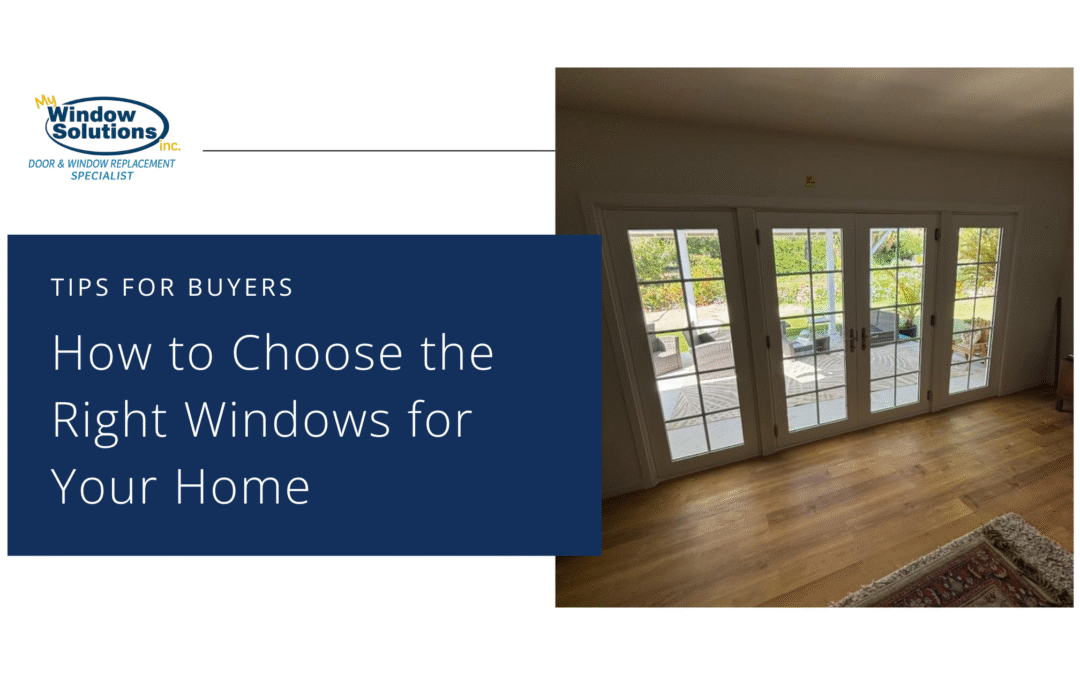- Choosing windows based on room function, climate, and orientation helps create a more comfortable, energy-efficient, and well-designed home.
- Materials, glazing, and proper installation all contribute to performance, durability, and long-term value in both new and existing homes.
- My Window Solutions offers expert guidance to help homeowners select high-quality windows tailored to their home’s style, needs, and energy goals.
Windows do more than bring in sunlight and fresh air—they influence your home’s efficiency, comfort, appearance, and value. Choosing the right ones requires careful thought about function, design, climate, and long-term plans for the property. Whether you’re replacing old units or designing for a new build, your window choices will have lasting consequences. That’s why this process deserves more than just a quick scan of styles or price tags.
The window industry offers an impressive array of materials, technologies, and custom options. While that’s great for homeowners who want tailored performance, it can be overwhelming without a plan. The best approach starts by identifying your home’s specific needs. From there, you can weigh performance ratings, explore design preferences, and match windows to your lifestyle and location.
Here’s a deeper look at what to consider when choosing the right windows for your home, so you can invest wisely and enjoy the results every day.
Consider the Purpose of Each Room
It may sound simple, but different rooms require different kinds of windows. A window that performs beautifully in the kitchen may not suit a bedroom or living room. Start by thinking about what each space needs from its windows. Is it light, air, privacy, noise reduction, or something else?
In bedrooms, operable windows that allow for fresh air are often prioritized. Casement or double-hung styles allow airflow while maintaining energy efficiency. Living rooms may benefit from large fixed picture windows that frame views and flood the space with natural light. Meanwhile, kitchens and bathrooms require a balance between ventilation and privacy.
Rather than selecting one style for the entire home, think about layering functionality across different areas. Matching the window to the room’s purpose ensures your home performs better in both form and function.
Evaluate Climate and Orientation
Your climate and how your home is positioned on the lot will directly influence which windows make sense. Sun exposure, wind direction, temperature swings, and regional weather events all affect performance expectations.
In hot regions, minimizing solar heat gain can help reduce energy bills. Low-emissivity (Low-E) glass with specific coatings can deflect heat while still allowing light in. In colder climates, insulated glazing and gas-filled panes help maintain indoor comfort and reduce heat loss. Areas prone to storms may benefit from impact-resistant windows or reinforced frames.
Orientation matters, too. South-facing windows tend to receive the most sunlight, while north-facing ones may need extra insulation. East- and west-facing windows bring in morning and evening sun, which can create glare or heat buildup depending on the season. By aligning your window choice with your home’s exposure and regional weather, you support long-term efficiency without sacrificing comfort.
Understand Frame Materials and Their Impact
Frame material affects much more than appearance. It plays a major role in energy efficiency, maintenance, and durability. Choosing the right frame starts with understanding the strengths and trade-offs of each option.
Wood is known for its beauty and natural insulating properties. It offers excellent energy performance and can be painted or stained. However, it requires ongoing maintenance and may not hold up well in areas with high humidity or frequent rain unless it’s properly treated.
Vinyl frames are popular for their affordability and low maintenance. They resist moisture, don’t require painting, and can deliver strong thermal performance. While they come in limited colors, modern finishes have improved aesthetics without sacrificing function.
Aluminum frames offer strength and a slim profile, making them a good match for modern architecture. They conduct heat more than other materials, so they’re often used with a thermal break to improve efficiency. They hold up well in warm, dry climates but are less ideal for colder regions unless thermally enhanced.
Fiberglass is gaining attention for its durability and energy efficiency. It resists warping and swelling and can mimic the look of wood while outperforming it in strength and lifespan. It tends to cost more up front but pays off with longevity and minimal upkeep.
Choosing a frame material that aligns with your priorities, whether it’s appearance, budget, or performance, gives you a strong foundation for your window decisions.
Glazing Options: More Than Just Double-Pane
When it comes to glass, most homeowners have heard of double-pane windows, but there’s more to consider. The number of panes, the gas between them, and the type of coating used all affect performance.
Double-pane windows with an argon gas fill provide solid insulation and are standard in many homes. Triple-pane windows increase thermal performance even further and can help reduce noise, making them appealing for homes in busy neighborhoods or colder regions.
Low-E coatings on the glass help regulate heat transfer and UV exposure. This reduces fading on furniture and flooring and improves energy efficiency. Some coatings are tailored for hot climates, while others are optimized for retaining heat in cooler areas.
Tinted or reflective coatings offer privacy and reduce glare but may affect visibility or daylight levels inside. The right glazing option will depend on your climate, how much noise control you want, and how important UV protection is to you.
Style and Architecture: A Seamless Fit
It’s easy to get distracted by trendy designs or oversized panes, but the right window should enhance your home’s architecture rather than compete with it. Matching window style to the home’s era and layout ensures visual harmony.
For traditional homes, double-hung or casement windows often complement the design. Colonial or Craftsman styles may benefit from grilles or divided lites that mimic period details. Modern homes typically favor clean lines, large expanses of glass, and minimal framing.
It’s also worth considering the size and proportion of each window. Oversized windows may look dramatic, but could overwhelm a small room. Too-small windows in large spaces may make a home feel dark or closed off. Let your home’s architectural language guide your window choices, and you’ll achieve a cohesive look that feels intentional.

Don’t Overlook Operation and Safety
How a window opens and how easily should influence your decision. Window operation matters not just for ventilation, but also for cleaning, security, and ease of use.
Double-hung windows slide vertically and can tilt in for cleaning, making them ideal for second-story rooms. Casement windows open outward with a crank, sealing tightly when closed and offering excellent ventilation. Sliding windows are practical for tight spaces like above kitchen sinks. Awning windows hinge at the top and swing out, making them suitable for basements or rainy climates.
If you have young children, security features and operable limits may be necessary. Tempered glass, locks, and secure hardware reduce risk and improve peace of mind. Fire safety codes also require egress windows in bedrooms, so the size and operation type must align with those guidelines.
Aesthetics should never come at the cost of practicality or safety. Make sure you choose a style that fits your space and works for how you live in it.
Think Long-Term: Maintenance and Durability
Windows are a long-term investment, and their performance depends on how well they stand up to time, weather, and use. Some materials demand frequent upkeep; others are virtually maintenance-free. Think about what level of involvement you’re comfortable with.
Wood may require periodic staining or painting, especially in climates with extreme weather. Vinyl resists fading and doesn’t need paint, but it may warp under intense heat if poorly manufactured. Aluminum won’t rust but may show signs of corrosion in coastal environments unless treated. Fiberglass resists all of the above and handles temperature changes with minimal expansion and contraction.
Also, pay attention to warranties and service options. A longer warranty doesn’t just cover defects; it suggests the manufacturer has confidence in its product. Knowing your windows will hold up over decades adds real value to your home and peace of mind to your decision.
Energy Ratings That Actually Matter
Window performance is measured through ratings that give real insights into how a window will perform. The National Fenestration Rating Council (NFRC) provides standardized metrics to compare different products.
The U-Factor measures how well a window insulates; lower numbers mean better thermal performance. Solar Heat Gain Coefficient (SHGC) measures how much solar radiation passes through; a lower SHGC is better for warm climates. Visible Transmittance (VT) tells you how much natural light the window allows in, and Air Leakage (AL) indicates how much air can pass through the window assembly.
Rather than chasing the lowest number across the board, match the ratings to your region. For example, a high VT and low SHGC may be ideal in hot climates, while cold regions benefit from a low U-Factor and higher SHGC to allow in warming sun.
Windows with ENERGY STAR® certification meet performance criteria for specific climate zones and are a strong baseline for energy-conscious homeowners. Still, dig deeper than the label to choose what works for your goals.
Installation Makes or Breaks the Investment
Even the highest-quality windows will underperform if installed incorrectly. Poor sealing, improper alignment, and shortcuts during installation can lead to drafts, water leaks, and reduced energy efficiency. That’s why it’s worth working with professionals who specialize in window installation and understand how to integrate them into your home’s envelope.
Ask about the installation process, what sealants and materials are used, and how the team handles insulation around the frame. Well-installed windows reduce long-term maintenance issues and maximize the return on your investment. A good installation also ensures your warranty remains valid.
Choosing windows is only half the job, and how they’re installed can determine whether you see the performance you’re expecting.
Budgeting with Priorities in Mind
Window costs can vary widely depending on materials, sizes, features, and customizations. Instead of focusing purely on the price tag, think about value over time. That includes reduced energy bills, increased comfort, and fewer replacements or repairs.
Start with your highest-priority rooms, such as bedrooms or living areas, and choose performance features that meet your goals. In lower-traffic areas, you may scale back on premium upgrades. Blending tiers of window types across the house can help you stay within budget while maximizing benefits where they matter most.
Factor in installation, future maintenance, and potential energy savings when comparing costs. What appears affordable at first might end up costing more in upkeep. On the flip side, a high-performance window could pay for itself in utility savings and comfort over the years.
Take your time, ask thoughtful questions, and work with professionals who understand how to balance technical performance with visual appeal. The right windows don’t just close out the weather—they open your home to light, air, and a better way of living.
Learn more about your window options with guidance grounded in design, performance, and practical experience. At My Window Solutions, our team helps you make informed decisions, so your home works better for the way you live, season after season, year after year. Contact us today.


